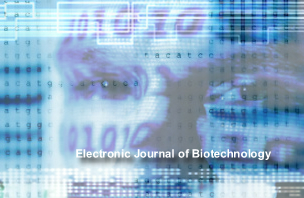
|
Electronic Journal of Biotechnology
Universidad Católica de Valparaíso
ISSN: 0717-3458
Vol. 26, No. 1, 2017, pp. 52-59
|
 Bioline Code: ej17022
Bioline Code: ej17022
Full paper language: English
Document type: Research Article
Document available free of charge
|
|
|
Electronic Journal of Biotechnology, Vol. 26, No. 1, 2017, pp. 52-59
| en |
Improving the thermostability of Trichoderma reesei  xylanase 2 by introducing disulfide bonds xylanase 2 by introducing disulfide bonds
Tang, Feng; Chen, Daiwen; Yu, Bing; Luo, Yuheng; Zheng, Ping; Mao, Xiangbing; Yu, Jie & He, Jun
Abstract
Background: Xylanases are considered one of the most important enzymes in many industries. However, their
low thermostability hampers their applications in feed pelleting, pulp bleaching, and so on. The main aim of
this work was to improve the thermostability of Trichoderma ressei xylanase 2 (Xyn2) by introducing disulfide
bonds between the N-terminal and α-helix and the β-sheet core.
Results: In this work, two disulfide bonds were separately introduced in the Xyn2 to connect the N-terminal and
α-helix to the β-sheet core of Xyn2. The two disulfide bondswere introduced by site-directed mutagenesis of the
corresponding residues. The half-life of the mutants Xyn2C14–52 (disulfide bond between β-sheets B2 and B3) and
Xyn2C59–149 (disulfide bond between β-sheets A5 and A6) at 60°C was improved by approximately 2.5- and
1.8-fold compared to that of the wild type Xyn2. In addition, the enzyme's resistance to alkali and acid was
enhanced.
Conclusion: Our results indicated that the connection of the N-terminal and α-helix to the β-sheet core is due to
the stable structure of the entire protein.
Keywords
Disulfide bond introduction; Feed pelleting; Glycoside hydrolase; Industry applications; Pulp bleaching; Site-directed mutagenesis; Stable xylanase; Xylan degradation; Xylanolytic enzymes
|
| |
© Copyright 2017 - Pontificia Universidad Cat\u00f3lica de Valpara\u00edso
Alternative site location: http://www.ejbiotechnology.info
|
|
